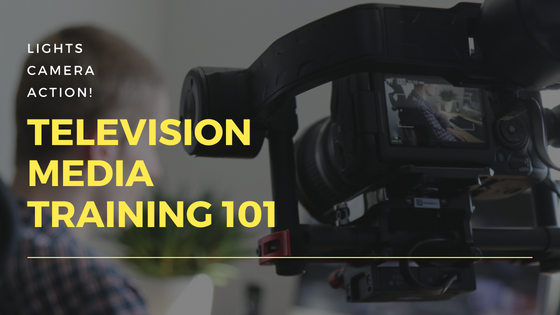Lights, Camera, Action! Television Media Training 101
Public Relations professionals are often assigned the role of a spokesperson or asked to execute media training for clients. While you might be comfortable speaking about your company, it’s another story to feel confident at a television studio and using effective communication on camera. Do you make eye contact with the camera? How much room will you have for props? Are you prepared for unexpected questions? Here are eight TV interview tips designed to help nail your next segment.

The Interview Starts Before the Mic is on
In most cases, you’ll have a few minutes to chat with the anchor before going live. Use this time wisely and share why you’re looking forward to bringing the topic to their audience or point out a unique element/handling of a prop. Often, this can help direct the questions asked on-air, so make the small talk count!
Kick It Up a Notch
Media segments often take place early in the morning, so it’s important to bring enthusiasm and a high energy level. Create extra excitement in your voice – if you’re excited about the topic, your interviewer and the audience are more inclined to feel the same. What may seem as over-the-top to you comes across as “normal” on camera, while your “regular” conversational tone may be viewed as tiresome. Remember to smile – you won’t always be aware when the camera is focused directly on you (this includes teasers leading up to the segment).
Where to Look and How to Look
Always keep your eyes on the interviewer, not the camera. It should appear as if you are having a conversation with a friend.
Dress appropriately for the topic and the client’s tone – this can range from a branded t-shirt to business casual attire. Keep it simple and forgo heavy fabrics (the lights can get hot!) and avoid busy patterns or distracting jewelry that might turn your appearance into the focal point.
Practice Makes Perfect
Take the time to repeat talking points out loud enough times that the words flow naturally. Study key messages, but be sure to practice putting answers in your own words for authenticity.
- Be aware of your interview time: most segments are only two or three minutes and timing yourself will ensure answers remain concise.
- Slow down! People tend to speak quickly when they are nervous.
- It’s okay to pause and think about the question before you reply.
- Replace the word “we” with the company name or product.
- Determine if you’ll be sitting or standing and if standing, practice keeping your feet planted firmly on the ground to avoid swaying.
You are the Expert!
In some cases, the anchor may not review your topic until just a few minutes before the interview. If they leave out a vital fact, it’s appropriate to bring it up on your own to help guide the conversation.
Brainstorm “tough questions” that may come up and exactly how you will respond to them effectively. If you simply don’t know the answer to a question, bridge to “I’m not sure about that, but what I can tell you is…” to bring the segment back on track.
Make it Visual
Bring visual elements to the interview by submitting video, images or bringing in props. Narrow it down to three or four products that will fit the timeframe, are easy to handle and won’t be impacted by overhead lights (such as food). Practice setting up the display ahead of time (with products facing the camera) to remain efficient on-site. When handling a prop, hold it steady for a couple of seconds for the camera to zoom in. If you can’t reach the prop from your position, simply gesture to it. Hold the gesture so the camera can easily follow you, and viewers have a chance to identify which prop you’re referencing.
Go with the Flow
Breaking news happens. Your airtime might get delayed, prop set-up time might be reduced or the time segment may get cut in half. Keep calm, stay focused and go with the flow. Being able to adapt to the studio changes will mark you as a reliable guest for future segments.
Parting Thoughts
“Anything else you’d like our viewers to know?” This often arises at the end of the interview and there’s always something to add, such as directing them to a website. If you’re prepared with extra content in your back pocket, parting words aren’t an opportunity to be missed!
Author
Related Posts
Collaboration Drives Sustainable Tourism
Sustainable tourism has growing importance in the world of travel and tourism. As destinations grow in popularity, they need to collaborate closely with residents, local…
Marketing for Group Travel: Building Solid Relationships with Tour Operators
Group travel is a significant segment of the tourism market, and if you want to see those buses pulling up to the curb and filling…
